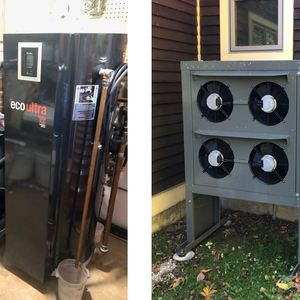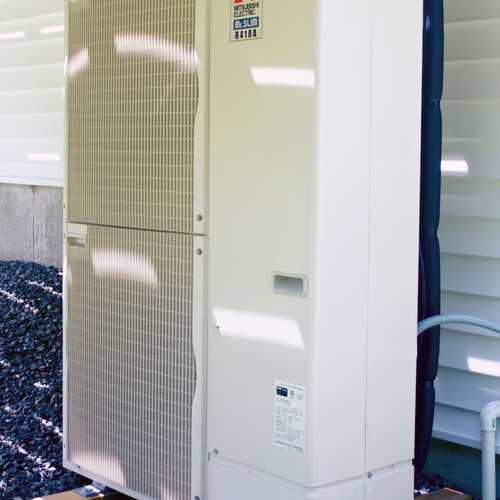
Oh, the wonderful world of heating and air conditioning and its confusing terminology. I’ve been doing building science for nearly two decades now, and I still have to ask around sometimes to find out what a particular term means. Here’s the one that got me going on this today:
Air-to-water heat pump
You probably know that a heat pump is a clever device that can move heat from a warm place to a hot place, as unlikely as that sounds. And for its second trick, it can also move heat from a cold place to a warm place. It’s actually the same trick, involving two heat reservoirs, one known as the source and the other as the sink.
Once you have that basic knowledge, you can look at the term “air-to-water heat pump” and deduce that the air and the water must be the source and the sink. Right? But which is which? And does it change with the seasons as a heat pump switches between cooling and heating modes?
As I’ve seen this term used over the years, I’ve come to see that it’s mostly used in ways that imply that the first part, air in this case, refers to the outdoor heat exchange, and the second part refers to the indoor heat exchange. So, an air-to-water heat pump would be what’s also called an air-source heat pump with hydronic distribution.
In plain English, that means the outdoor unit uses the outdoor air as a sink for dumping heat from indoors when it’s cooling the house and as a source of heat to warm the house in winter. The indoor unit collects or distributes heat with water running through pipes connected to radiant panels or some kind of radiator, like the one shown in the lead photo.
Occasionally, I’ve tried to find a source (heh, heh, heh!) that could verify that as the correct usage, always unsuccessfully. Recently, I asked three of my go-to HVAC buddies (John Semmelhack, Mike MacFarland, and Kristof Irwin) about this term, and they all confirmed that my assumption is correct. MacFarland even sent me a paragraph from a book titled Troubleshooting & Servicing Heat Pump Systems by Richard Jazwin, which states, “The first word in the description identifies the physical location of the outdoor coil.”
From that, you can figure out exactly what kind of system would be called air-to-air (the most common configuration), water-to-air, water-to-water, or even a nonexistent one like water-to-wine. We know the formula, and now it’s easy to decipher any combination.
Of course, if water is the first term, we could make things even more confusing by trying to describe what kind of system uses water for the outdoor heat exchange. Is it a geothermal heat pump? A ground-source heat pump? A water-source heat pump? Geoexchange? Earth-coupled? Oh, the fun we could have!
But this is New Year’s Eve, and even in a pandemic, I’m going to save up some fun for this evening. Happy New Year, everyone!
_________________________________________________________________________
-Allison Bailes of Atlanta, Georgia, is a speaker, writer, building science consultant, and founder of Energy Vanguard. He is also the author of the Energy Vanguard Blog. You can follow him on Twitter at @EnergyVanguard.
Weekly Newsletter
Get building science and energy efficiency advice, plus special offers, in your inbox.















2 Comments
Would water-source wine cellar cooling units like these count as water to wine?
https://wineguardian.com/water-cooled-systems/
Here's hoping for some kind of magical transformation in this new year--pandemic to normal life would be wonderful.
Until recent warmer summers due to climate change, here in the mild maritime climate of the UK we are largely non-cooling, so we chiefly have wet heating systems in our existing houses, as all we have needed has been heating. As a result when we retrofit heat pumps of any type, they are commonly '-to-water'.
So we often talk of air-source heat pumps, generally meaning, in our context, air to water, without saying so. Similarly when we talk of water-source heat pumps here, we generally mean water-to-water, although I guess there may be water-to-air systems both here in Europe and also perhaps in cool maritime areas of north America(?).
The other confusion to my mind is that if I understand correctly water-source heat pump systems use the same actual pump as ground source heat pump systems. This I believe is due to the fact that in a ground source system the loop in the ground is generally in fact full of water (or water-with-glycol), if I am right. So as far as the pump itself is concerned, the ground source system looks just like a water-source system. So if you want to research pumps for your (less common) water source system, you should look in fact at ground source heat pumps, if I understand correctly.
Personally I am currently attempting to establish whether a spring flowing at approximately 30 litres (8 US gallons) per minute and at a steady 9 degrees Celsius (48 F) all year round will give us enough heat for our house if we manage to retrofit the house to consume a maximum of 5kW for heating (at a design temperature of -3 degrees or so). An open loop system may be possible, the only contamination in the spring water being particles of iron. Any thoughts welcome.
Log in or create an account to post a comment.
Sign up Log in